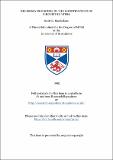Helisoma neurones in the construction of circuits in vitro
Abstract
The work described here used the invertebrate neurone culture methodology to study neurones from the pond snail Helisoma trivolvis. Isolated neurones were used to form small circuits, the input/output properties of which were investigated electrophysiologically. The activity of the circuits were then described with respect to the intrinsic properties of the individual neurones and the synaptic connections between them. Neurite extension from isolated neurones could be altered by making changes to the culture medium in which the neurones were maintained. Electrophysiological recordings made from pairs of neurones in culture revealed electrical, chemical and mixed connections. The purely chemical connections and the chemical component of the mixed connections were inhibitory in nature. Connections were not detected between all of the pairs. In many cases no connections at all were recorded between neurone pairs. Connections could also be obtained between neurone pairs if the two neurones were placed in culture on consecutive days. Connections were still obtained when three neurones were placed together to form circuits, although such connections were found to be weak. The three neurone circuits formed were unable to produce any rhythmic output, due both to the weak synaptic connections present and intrinsic membrane properties of the neurones. This study shows that invertebrate neurone culture is a viable way to study small circuits of neurones.
Type
Thesis, MPhil Master of Philosophy
Collections
Items in the St Andrews Research Repository are protected by copyright, with all rights reserved, unless otherwise indicated.

